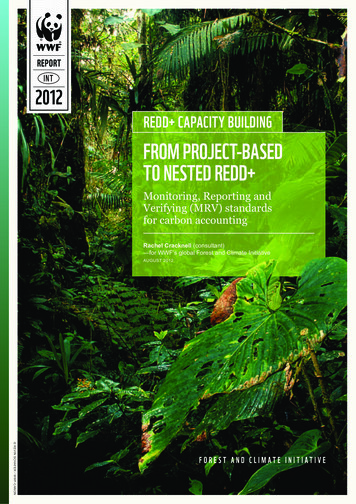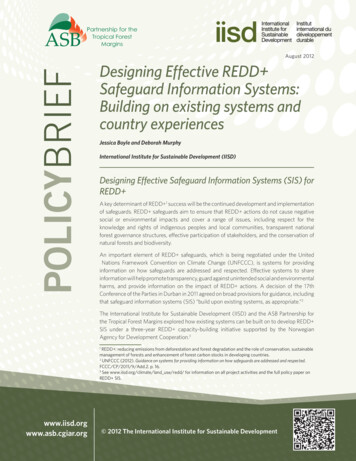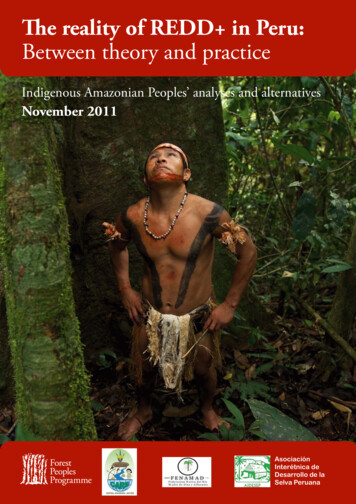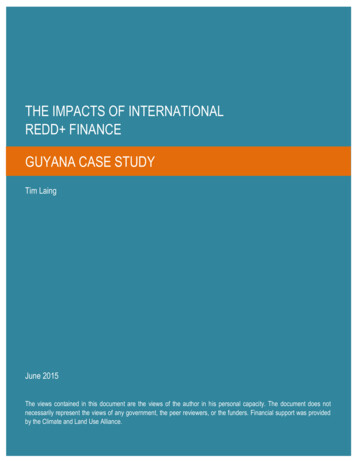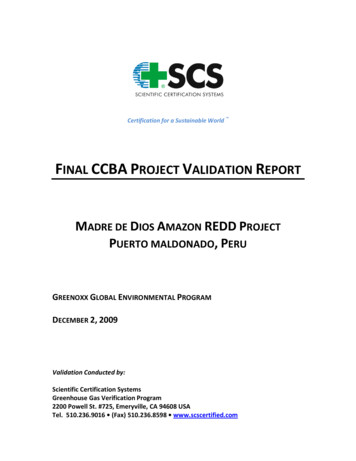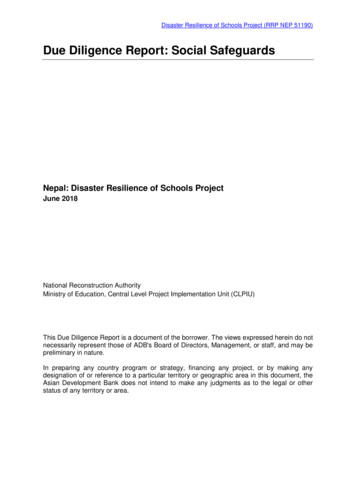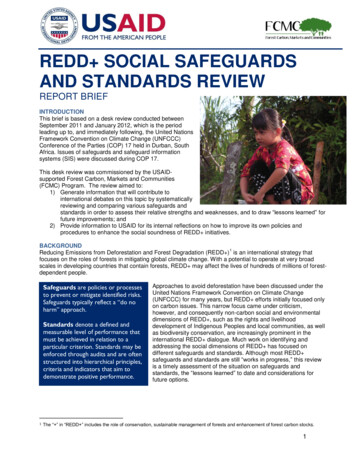
Transcription
REDD SOCIAL SAFEGUARDSAND STANDARDS REVIEWREPORT BRIEFINTRODUCTIONThis brief is based on a desk review conducted betweenSeptember 2011 and January 2012, which is the periodleading up to, and immediately following, the United NationsFramework Convention on Climate Change (UNFCCC)Conference of the Parties (COP) 17 held in Durban, SouthAfrica. Issues of safeguards and safeguard informationsystems (SIS) were discussed during COP 17.This desk review was commissioned by the USAIDsupported Forest Carbon, Markets and Communities(FCMC) Program. The review aimed to:1) Generate information that will contribute tointernational debates on this topic by systematicallyreviewing and comparing various safeguards andstandards in order to assess their relative strengths and weaknesses, and to draw “lessons learned” forfuture improvements; and2) Provide information to USAID for its internal reflections on how to improve its own policies andprocedures to enhance the social soundness of REDD initiatives.BACKGROUND1Reducing Emissions from Deforestation and Forest Degradation (REDD ) is an international strategy thatfocuses on the roles of forests in mitigating global climate change. With a potential to operate at very broadscales in developing countries that contain forests, REDD may affect the lives of hundreds of millions of forestdependent people.Safeguards are policies or processesto prevent or mitigate identified risks.Safeguards typically reflect a “do noharm” approach.Standards denote a defined andmeasurable level of performance thatmust be achieved in relation to aparticular criterion. Standards may beenforced through audits and are oftenstructured into hierarchical principles,criteria and indicators that aim todemonstrate positive performance.1Approaches to avoid deforestation have been discussed under theUnited Nations Framework Convention on Climate Change(UNFCCC) for many years, but REDD efforts initially focused onlyon carbon issues. This narrow focus came under criticism,however, and consequently non-carbon social and environmentaldimensions of REDD , such as the rights and livelihooddevelopment of Indigenous Peoples and local communities, as wellas biodiversity conservation, are increasingly prominent in theinternational REDD dialogue. Much work on identifying andaddressing the social dimensions of REDD has focused ondifferent safeguards and standards. Although most REDD safeguards and standards are still “works in progress,” this reviewis a timely assessment of the situation on safeguards andstandards, the “lessons learned” to date and considerations forfuture options.The “ ” in “REDD ” includes the role of conservation, sustainable management of forests and enhancement of forest carbon stocks.1
SAFEGUARDS AND STANDARD SYSTEMS REVIEWEDThis report reviewed the following safeguard and standard systems currently in use or under development forREDD , as well as some additional standard and certification systems being applied in related spheres.Although all of these approaches treat social and environmental standards together, this review focuses only ontheir social components:Seven UNFCCC Safeguards:Multilateral Approaches1. The UNFCCC Cancun Safeguards: TheUNFCCC REDD safeguards agreed upon in2010 will be the default safeguards forinternational performance. Under the UNFCCC,REDD programs should be designed to upholdthese safeguards as an absolute minimumperformance requirement.1. Complement or consistent with the objectivesof national forest programmes and relevantinternational conventions and agreements2. Transparent and effective national forestgovernance structures3. Respect for the knowledge and rights ofindigenous peoples and members of localcommunities4. Full and effective participation of relevantstakeholders5. Consistent with the conservation of naturalforests and biological diversityo Not used for conversion of naturalforestso Protection and conservation of naturalforests and their ecosystem serviceso Enhance other social andenvironmental benefits6. Address the risks of reversals7. Reduce displacement of emissions2. Use and Adaptation of World Bank Safeguardsby the FCPF, the FIP and the GEF: TheFCPF‘s approach to safeguards represents aminor adaptation of long-established WorldBank project practices. The FCPF CharterDocument and the Common Approach toEnvironmental and Social Safeguards forMultiple Delivery Partners documents are thekey policies that specify that the World Banksafeguards will be used. Two World Banksafeguards—Operational Policies andassociated Bank Procedures—focus onrelevant social issues concerning IndigenousThe UNFCCC also requests that developingPeoples (OP /BP 4.10) and Resettlementcountry partners address drivers of deforestation(OP/BP 4.12). For the FCPF, a participatingand forest degradation, land tenure issues, forestcountry must conduct a Strategicgovernance issues and gender considerations,Environmental and Social Assessment (SESA),when developing and implementating theirwhich should inform a country‘s nationalnational strategies or action plans.REDD Strategy. An over-archingEnvironmental and Social Management Framework (ESMF) provides the framework for risk mitigationplans and is intended to ensure compliance with the safeguards.The Forest Investment Program (FIP)8.and the Global Environment Facility (GEF) also use or adapt these safeguards.3. UN-REDD Social and Environmental Principles and Criteria: The UN-REDD utilizes a human rightsbased approach to safeguards through its Social and Environmental Principles and Criteria (SEPC). Thesafeguards are intended for activities financed through UN-REDD, which only supports readinessactivities. A Benefits and Risks Tool (BeRT) has been developed to help apply the SEPC (2011). UNREDD also prepared Guidelines on Stakeholder Engagement (with FCPF) and Seeking Free Prior andInformed Consent (2011), as well as Guidance for the Provision of Governance Information on REDD (2011).Bilateral Approaches4. Bilateral Donors: Norway, Australia and Germany: None of the bilateral donors reviewed here hasarticulated a specific set of safeguards, operational principles or standards for their work in REDD . Todate, the donors have avoided explicit social policies or standards, especially insofar as they have agreed,in the Paris Declaration on Aid Effectiveness, to align with host country policies. Some default to theiroverseas development assistance (ODA) principles, even though their coverage of relevant issues isincomplete. In 2011, Germany adopted a general human rights-based policy for all its development work.Another strategy (applied by Norway in Indonesia) is to default to safeguards of other REDD deliverypartners. Many donors pursue social issues related to REDD by providing grants to civil society andresearch organizations in host countries or by supporting consultative policy processes in host countries,but these are not necessarily grounded in a particular safeguard or standard system.2
Non-governmental Organization (NGO) Initiatives5. Climate Community and Biodiversity Standard (CCBS or CCB Standards): The Climate, Communityand Biodiversity Alliance (CCBA) has developed the CCB Standards, which is a voluntary project-levelsocial and environmental standard with which independently audited projects can demonstrate the socialand environmental integrity of their activities from design through implementation. These standards weredeveloped in response to the fact that the Verified Carbon Standards (VCS) used in many pilot forestcarbon standards were weak on social and environmental factors. The CCB Standards are particularlystrong on community benefits and reward outstanding performance through its “Gold Level.” Manyprojects have now been developed to meet both the VCS and CCB Standards.6. REDD Social and Environmental Standards (REDD SES): REDD SES have been under developmentsince 2009 through an inclusive process engaging governments, NGOs, civil society organizations(CSOs), Indigenous Peoples (IP) organizations, international policy and research institutions, and theprivate sector, under the facilitation of CARE International and the CCBA. The initiative aims to developclear, easy-to-follow, country-specific, national-level REDD standards for use by governments through amulti-stakeholder process to comply with the minimum official safeguards for REDD emerging fromUNFCCC negotiations. At the same time, the initiative aims to define and build support for better socialand environmental performance from REDD programs.7. Brazilian and Indonesian Civil Society Initiatives: In 2009-2010, civil society representatives led a multistakeholder process to develop social and environmental safeguards, with principles and criteria, forBrazil. This document is contributing to the national REDD debate. Moreover, Brazil‘s NationalDevelopment Bank (BNDES), which is managing the Amazon Fund, is using these safeguards asreference guidelines to complement the bank‘s own Protocol. Indonesia‘s Civil Society Network for ClimateJustice (HuMa) has developed a proposal for Human Rights-Based Safeguards for use in climateadaptation, mitigation and REDD .Other Relevant Initiatives8. Lessons from Other Initiatives:o The Forest Stewardship Council (FSC) Standards employ nationally adapted indicators to aninternational set of principles and criteria. They also offer a flexible and graduated approach tocompliance, providing some incentives and—more importantly, time—for the complex business ofattaining best practices.o Fairtrade certification for small producers recognizes the importance of internal group governanceissues, such as inclusive participation, equity, and transparent financial management, to achieving socialobjectives. It also provides support to producer groups to improve their performance in these areas.o The Convention on Biological Diversity (CBD) has developed the Akwe: Kon Voluntary Guidelines,which focus on the assessment of the impacts of conservation projects on indigenous people. Theseguidelines prescribe local multi-stakeholder platforms for approaching indigenous issues. CBD also hasan Indigenous Forum on Biodiversity, which enables indigenous groups to lobby the Convention directlywhen problems arise.o The WWF’s meta-standard for carbon projects supports the idea of “drop out” criteria, i.e., seriousinfractions that will trigger the cancellation of a project.o The UNFCCC’s Clean Development Mechanism (CDM) has social and environmental criteria forvalidation and verification of projects, which must be met before the projects can proceed; however, nostandards were developed.SOCIAL ISSUES IN REDD This report reviewed a range of social issues addressed in the existing safeguard and standard schemes,including upholding international conventions and treaties, rights, benefits and poverty alleviation, governance,avoided involuntary resettlement and grievance mechanisms/access to justice, as well as if and to what extentthey are addressed in each scheme. The following table illustrates the prominence (or absence) of key socialissues across the reviewed safeguard and standard schemes.3
Figure 2: Social Issues Addressed in Safeguards and Standards Systems Respect culture & indigenoustraditional knowledgeGenderXX(x)Poor and Vulnerable GroupsEquitable Benefit SharingEnhanced Livelihoods(x)(x) Poverty alleviation Climate change adaptation(x)Avoided ResettlementXRecourse/Grievance MechanismsXMonitoring, ReportingXGood GovernanceX Fiduciary integrity Uphold national laws Labor standardsKey: X strong mention or ary issueSecondary andardHuMaXWWF Meta-Brazilian CSOs(number)REDD SESAustraliaSummaryCCBS(x)NorwayXGermanyFCPF CarbonXon Gender and Social Equity Free Prior Informed ConsentXXOtherOrganizationsNo specific REDD safeguards or standards, but ODA policies strongX(x)(x)poverty alleviation and social and economic development invokedIndigenous Peoples’ Rights(x)No specific REDD safeguards or standards, but ODA objectives of RepresentationXstrategies and action plans touching on many issuesX(x)No specific REDD safeguards or standards, but diverse set ofX Right to informationGEFXUN-REDDStakeholder Participation(x)NGOs or Int’l.BilateralsFIPProperty RightsXcomponent of candidate countries’ “market readiness”International ConventionsWill apply UNFCCC and FCPF Common Approach to assess safeguardaddressedFundSocial Issues in REDD upheld orFCPF ReadinessStandards System UNFCCCSafeguards 1XXXXX(x) weaker mention or relevance4X
KEY FINDINGS In terms of content, the clearest, most comprehensive and most rigorously worded REDD social standards are those of UN-REDD and those of a few international multi-stakeholder platforms(i.e. the REDD Social and Environmental Standards, referred to as REDD SES) and the civil society(Brazilian civil society organizations and the Climate, Community and Biodiversity Standards (CCBS)).Most apply a principles, criteria and indicators approach; In terms of process, the REDD SES Initiative is very strong since its principles, criteria andindicators have been generated though multi-stakeholder processes at the international level, and thecriteria and indicators are then adapted through national multi-stakeholder processes to individualnational contexts. This approach greatly increases local understanding of the issues while itsimultaneously builds consensus and promotes ownership of REDD and its social standards.Moreover, it provides a framework for monitoring and reporting; The UNFCCC, multilateral and bilateral safeguards tend to be weaker in terms of both obligationsand process, which may reflect the nature of the political compromises needed to reach agreement; “Safeguard” policies and processes that only aim to minimize or prevent REDD ’s negativeimpacts do not go far enough on their own. Standards that are clearly structured and nested atproject, national and international levels, as well as strong but adaptable compliance mechanisms toensure they are met, are also needed—particularly to deliver the benefits and opportunities presentedby REDD ; None of the existing systems of safeguards or standards reviewed covers the full range ofsocial issues in REDD . At this stage, however, the priority should be focused on testing and learningfrom field experience, such as CCBS and REDD Social and Environmental Standards (REDD SES),to inform future revisions; and Simplicity in safeguards and standards will be the key to obtaining results, and social (andenvironmental) standards employing ―principles and criteria‖ offer the clearest logic for designers,implementers and participants of REDD at all levels.RECOMMENDATIONSSafeguards and Standards:REDD needs both safeguards with independent grievance mechanisms and standards, which applytransparent monitoring mechanisms and consequences for non-compliance: Safeguard policies and processes need to be more explicitly linked with standards for design,implementation, and monitoring; Support is needed for follow-up work on UNFCCC safeguards and safeguard information systems (SIS)issues emerging from the Durban COP 17; Development of the international REDD architecture should prioritize standards that includemonitoring and clear thresholds, with consequences for non-compliance; and REDD donors, particularly bilateral ones, can provide leadership on social (and environmental)standards in REDD by making them a priority in REDD programming and promoting them ininternational fora.Improving Safeguards and Standards, Piloting, and Promoting Best Practices:Development partners need to collaborate to develop a common approach to social and environmentalsafeguards (policies) and standards, then disseminate and publically uphold them in order to establish sociallyresponsible REDD as the international norm: Experience with piloting needs to be reviewed to identify strengths and weaknesses in the applicationof existing systems, and to use the findings to build on strengths and address weaknesses in order toidentify and develop “best practices.” Other relevant piloting, reviews, research studies and capacitybuilding on the application of safeguard and standards schemes should be supported;Internationally agreed-upon principles and criteria with nationally negotiated indicators, as being pilotedin the REDD Social and Environmental Standards, needs to be more broadly applied; andWhen a critical number of countries have engaged in this process and the revisions to the overallstandards system have been made, the UNFCCC, REDD countries and other REDD institutionsshould consider adopting the best practices from these standardsThis brief was developed by the USAID Forest Carbon, Markets and Communities Program (FCMC).5
private sector, under the facilitation of CARE International and the CCBA. The initiative aims to develop clear, easy-to-follow, country-specific, national-level REDD standards for use by governments through a multi-stakeholder process to comply with the minimum official safeguards for REDD emerging from UNFCCC negotiations.
